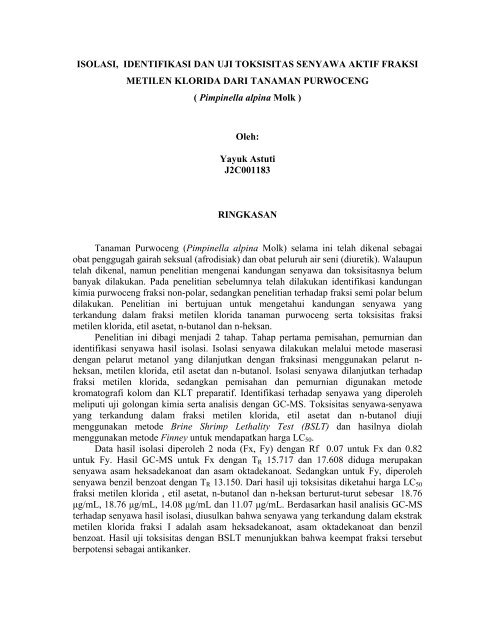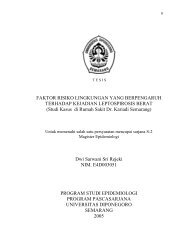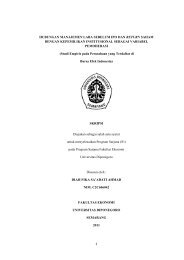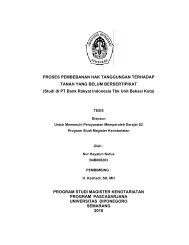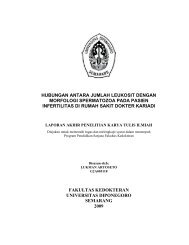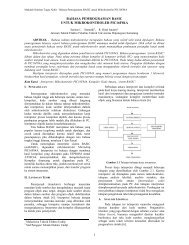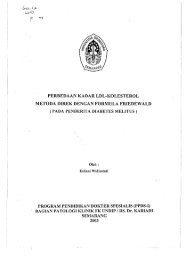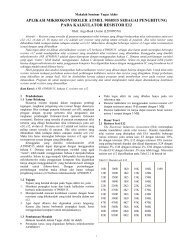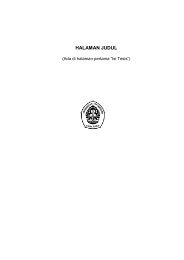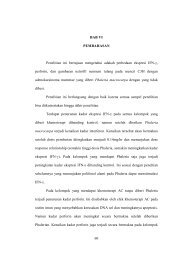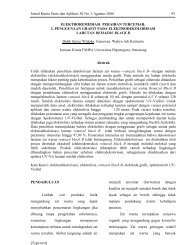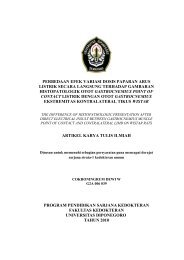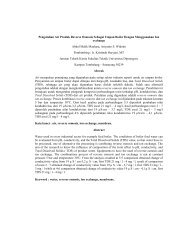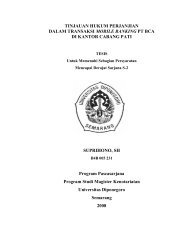isolasi, identifikasi dan uji toksisitas senyawa aktif fraksi
isolasi, identifikasi dan uji toksisitas senyawa aktif fraksi
isolasi, identifikasi dan uji toksisitas senyawa aktif fraksi
You also want an ePaper? Increase the reach of your titles
YUMPU automatically turns print PDFs into web optimized ePapers that Google loves.
ISOLASI, IDENTIFIKASI DAN UJI TOKSISITAS SENYAWA AKTIF FRAKSI<br />
METILEN KLORIDA DARI TANAMAN PURWOCENG<br />
( Pimpinella alpina Molk )<br />
Oleh:<br />
Yayuk Astuti<br />
J2C001183<br />
RINGKASAN<br />
Tanaman Purwoceng (Pimpinella alpina Molk) selama ini telah dikenal sebagai<br />
obat penggugah gairah seksual (afrodisiak) <strong>dan</strong> obat peluruh air seni (diuretik). Walaupun<br />
telah dikenal, namun penelitian mengenai kandungan <strong>senyawa</strong> <strong>dan</strong> <strong>toksisitas</strong>nya belum<br />
banyak dilakukan. Pada penelitian sebelumnya telah dilakukan <strong>identifikasi</strong> kandungan<br />
kimia purwoceng <strong>fraksi</strong> non-polar, se<strong>dan</strong>gkan penelitian terhadap <strong>fraksi</strong> semi polar belum<br />
dilakukan. Penelitian ini bertujuan untuk mengetahui kandungan <strong>senyawa</strong> yang<br />
terkandung dalam <strong>fraksi</strong> metilen klorida tanaman purwoceng serta <strong>toksisitas</strong> <strong>fraksi</strong><br />
metilen klorida, etil asetat, n-butanol <strong>dan</strong> n-heksan.<br />
Penelitian ini dibagi menjadi 2 tahap. Tahap pertama pemisahan, pemurnian <strong>dan</strong><br />
<strong>identifikasi</strong> <strong>senyawa</strong> hasil <strong>isolasi</strong>. Isolasi <strong>senyawa</strong> dilakukan melalui metode maserasi<br />
dengan pelarut metanol yang dilanjutkan dengan <strong>fraksi</strong>nasi menggunakan pelarut nheksan,<br />
metilen klorida, etil asetat <strong>dan</strong> n-butanol. Isolasi <strong>senyawa</strong> dilanjutkan terhadap<br />
<strong>fraksi</strong> metilen klorida, se<strong>dan</strong>gkan pemisahan <strong>dan</strong> pemurnian digunakan metode<br />
kromatografi kolom <strong>dan</strong> KLT preparatif. Identifikasi terhadap <strong>senyawa</strong> yang diperoleh<br />
meliputi <strong>uji</strong> golongan kimia serta analisis dengan GC-MS. Toksisitas <strong>senyawa</strong>-<strong>senyawa</strong><br />
yang terkandung dalam <strong>fraksi</strong> metilen klorida, etil asetat <strong>dan</strong> n-butanol di<strong>uji</strong><br />
menggunakan metode Brine Shrimp Lethality Test (BSLT) <strong>dan</strong> hasilnya diolah<br />
menggunakan metode Finney untuk mendapatkan harga LC50.<br />
Data hasil <strong>isolasi</strong> diperoleh 2 noda (Fx, Fy) dengan Rf 0.07 untuk Fx <strong>dan</strong> 0.82<br />
untuk Fy. Hasil GC-MS untuk Fx dengan TR 15.717 <strong>dan</strong> 17.608 diduga merupakan<br />
<strong>senyawa</strong> asam heksadekanoat <strong>dan</strong> asam oktadekanoat. Se<strong>dan</strong>gkan untuk Fy, diperoleh<br />
<strong>senyawa</strong> benzil benzoat dengan TR 13.150. Dari hasil <strong>uji</strong> <strong>toksisitas</strong> diketahui harga LC50<br />
<strong>fraksi</strong> metilen klorida , etil asetat, n-butanol <strong>dan</strong> n-heksan berturut-turut sebesar 18.76<br />
μg/mL, 18.76 μg/mL, 14.08 μg/mL <strong>dan</strong> 11.07 μg/mL. Berdasarkan hasil analisis GC-MS<br />
terhadap <strong>senyawa</strong> hasil <strong>isolasi</strong>, diusulkan bahwa <strong>senyawa</strong> yang terkandung dalam ekstrak<br />
metilen klorida <strong>fraksi</strong> I adalah asam heksadekanoat, asam oktadekanoat <strong>dan</strong> benzil<br />
benzoat. Hasil <strong>uji</strong> <strong>toksisitas</strong> dengan BSLT menunjukkan bahwa keempat <strong>fraksi</strong> tersebut<br />
berpotensi sebagai antikanker.
SUMMARY<br />
Purwoceng (Pimpinella alpina Molk) is a plant that is widely used as both diuretic<br />
and aphrodisiac. Although it has been widely used, the researches of its chemical<br />
compound and toxicity has not been done yet. In previous research had been identified<br />
the chemical compound from non polar fraction of purwoceng, but neither had been the<br />
semi polar fraction. The purposes of the researches are to do the isolation, identification<br />
and toxicity test of the compound from semi polar fraction (methylene chloride) of<br />
purwoceng.<br />
The research consists of two steps. In the first step covered isolating, purificating<br />
and identifying of resulted isolation compound. Compound isolation was done by<br />
maseration method using methanol which is continued by fractionation using n-hexan,<br />
methylene chloride, acetic ethyl and n-buthanol. Compound isolation was continued with<br />
methylene chloride fraction, while the separation and purification used preparative TLC<br />
and column chromathography methods. The identification of the resulted compound<br />
consist of phytochemistry screening and analysis by GC-MS. The compound activity<br />
which is contained in methylene chloride, ethyl acetat, n-buthanol and n-hexane fraction<br />
were tested using brine shrimp lethality test and the result are processed by the finney<br />
method to get the value of LC50.<br />
The result isolation obtained 2 stains ( Fx, Fy) with Rf 0.07 for Fx and 0.82 for Fy.<br />
GC-MS analysis for Fx with TR 15.717 and 17.608 was predicted to represent compound<br />
of heksadekanoat acid and oktadekanoat acid. While for Fy, was predicted to represent<br />
compound of benzil benzoat with TR 13.150. From result toxicity test was known value<br />
of LC50 of factions of methylene chloride , acetic ethyl, n-buthanol and n-heksane<br />
successively equal to 18.76 µ g/mL, 18.76 µ g/mL, 14.08 µ g/mL and 11.07 µ g/mL.<br />
Based on the analysis of GC-MS the isolation resulted compounds, it was suggested that<br />
the compounds contained in methylene chloride fraction I were hexadekanoic acid,,<br />
octadecanoic acid and benzyl benzoate. Based on LC50 value found that the all of fraction<br />
had potency as anticancer.
DAFTAR PUSTAKA<br />
Aboutabl, E. A., El-Azzouny, A. A., Afifi, M. S.,1998, “Phytochemistry”, 48 (3), p. 455.<br />
Ariens, E. J., Mutscler, E., Simonis, A. M., 1993, “Toksikologi Umum”, Gadjah Mada<br />
University Press, Yogyakarta.<br />
Cornu, A., Carnat, A. P., Martin, B., Lamaison, J. L., and Berdague, J. L., 2001, “Solid-<br />
Phase Microextraction of Volatile Component from Natural Grasslan<br />
Plants”, 49(1), pp. 208-209.<br />
Culvenor, C. C. J., Fitzgerald, J. S., 1963, “A Field Method for Alkaloid Screening of<br />
Plant”, Pharm. Sci, 52, p.303-304.<br />
Dewiyanti, Indah, D., Lenny, S., Pusra, D. N. L. , 2004, “J. Gulma sebagai Alternatif<br />
Pengobatan Diabetes Melitus”, vol. 39, No. 1, hlm. 19.<br />
Fessenden, R. J., & Fessenden, J. S., 1983, “Techniques & experiments for Organik<br />
Chemistry”, Willard Grant, Boston, pp. 105-108.<br />
Gunawan, D., 2000, “Ramuan Tradisional untuk Keharmonisan Suami Istri”, cetakan 2;<br />
Penebar Swadaya, Jakarta, hlm. 52-56.<br />
Harborne, J. B. ( a.b. Padmawinata, K., Sudiro, I. ), 1996,” Metode Fitokimia”, cetakan 2,<br />
ITB, Bandung, hlm. 123-152.<br />
Heyne, K. (a.b. Ba<strong>dan</strong> Litbang Kehutanan), 1987, “Tumbuhan Berguna Indonesia III”,<br />
Yayasan Sarana Wana Jaya, Jakarta, hlm. 1550.<br />
Ho Lee, Seung, gao Li, Hyo-Jin Kim, et al, 2003, “Two New Furanocoumarins from the<br />
Root of Angelica dahurica”, 24(11), pp. 1699-1700.<br />
30
Kader, M. S. A., 2003, “New Ester and Forukumarins from the Root of Pithuranthos<br />
tortuosus”, 24(1), pp. 48-51.<br />
Kisiel, W., Janeczo, Z., Zgud-Walaszek, M., 1998, “Phytochemistry”, 49(7) pp. 2031-<br />
2033.<br />
Koensumardiyah, 1987, Tesis Pasca Sarjana Farmasi, Universitas Gadjah Mada,<br />
Yogyakarta, hlm. 1-2.<br />
Kumar, R., 1999, “A Mass Spectral Guide for Quick Identification of Phtalate Esters”,<br />
American Laboratory Article: Washington, pp 34-35<br />
Loomis, T. A., 1978. “ Toksikologi Dasar”, Edisi Ketiga, IKIP Semarang Press, hlm. 16-<br />
20.<br />
Manske, R., H., F., 1950, “Marion in The Alkaloids”, vol.1, pp. 211-217.<br />
Marcias, M. J., 1994, “4-(B-D-Glucopyranosyloxy) Benzoic Acid, a Characteristic<br />
Phenolic Constituent of Apiaceae”, 23(8), pp. 1811-1812.<br />
McLafferty, F.W., 1980, “Interpretation of Mass Spectra”, University Science Books,<br />
New York.<br />
McLaughlin, J.L. Chang, D. L., 1991, “Bench Top Bioassay for the Discovery of<br />
Bioactive Natural product; An Update, the UNESCO regional Workshop on<br />
the Bioassay of Natural Product with Special Emphasis on Anticancer<br />
Agent”, University of Malaya, Kuala Lumpur, pp. 1-3.<br />
Meyer, B. N., 1982, “Brine Shrimp : A Convenient General Bioassay for Active Plant<br />
Constituent”, Journal of Medicinal Plant Research, 45, 31-33.<br />
Nordin, 1985, “Aspect of Natural Product Chemistry, Proceeding, The Phytochemical<br />
Survey”, Dept. Chemistry, UPM, Malaysia.
Pramono, S.; 1988, “Pemisahan Flavonoid” , Kursus Singkat Pemisahan Kimia, PAU<br />
Bioteknologi UGM, Yogyakarta, 7-9.<br />
Santos, P. M., Oliveira, M. M., Barroso, J. G., and Scheffer, J. C., 1998, “Essential Oils<br />
from Hairy Food Cultures and from Fruit and Roots of Pimpinella anisum”,<br />
48(3), pp. 455-460.<br />
Sastrohamidjojo, H., 1991, “Kromatografi”, edisi 2, cetakan 1, Liberty: Yogyakarta.<br />
Sastrohamidjojo, H., 1991, “Spektroskopi”, edisi 2, cetakan 1, Liberty: Yogyakarta.<br />
Silverstein, R. M., Bassler, C. G., Morril, T. C., (a.b. Hartono, V.P.), 1986, “Penyidikan<br />
Spektrometrik Senyawa Organik”, Erlangga: Jakarta.<br />
Stahl, E. and Herting, D., 1976, “Die Verteilung Von Inhaltsstoffen in Drei Pimpinella-<br />
arten”,vol. 15, pp. 997-1001.<br />
Sudjadi, 1985, “Penentuan Struktur Senyawa Organik”, cetakan 1, Ghalia: Jakarta.<br />
Supriadi, 2001, “Tumbuhan Obat Indonesia, Penggunaan <strong>dan</strong> Khasiatnya”, Pustaka<br />
Populer Obor.<br />
Suzery, M., Proceeding Seminar Nasional Hasil Penelitian MIPA, 2004, “Extraction of<br />
Essential Oil from Purwoceng (Pimpinella alpina Molk) Using Vacum<br />
Steam Destilation”, pp. 229-231.<br />
Suzery, M., Media Medika Indonesia, “Isolasi <strong>dan</strong> Karakterisasi Stigmasterol dalam<br />
Tanaman Purwoceng (Pimpinella alpina Molk)”, 39 (1), pp. 37-39.<br />
Taufiqqurachman, 1999, Tesis; Pasca Sarjana Kedokteran, Universitas Diponegoro,<br />
semarang, hlm. 1-4.<br />
Tjitrosoepomo, G., 1988, “Taksonomi Tumbuhan Spermatophyta”, Gadjah Mada<br />
University Press: Yogyakarta, hlm. 315.


